Abstract
N-Nitrosation of a model aromatic amine (2,3-diamino-naphthalene) by the N-nitrosating agent produced by nitrite in acidic solution was inhibited by a polyphenol, chlorogenic acid, which is an ester of caffeic acid quinic acid. Caffeic acid also inhibited the N-nitrosation, but quinic acid did not. 1,2-Benzenediols and 3,4-dihydroxybenzoic acid had inhibitory activities. Chlorogenic acid, caffeic acid, 1,2-benzenediols and 3,4-dihydroxybenzoic acid were able to scavenge the stable free radical, 1,1-diphenyl-2-picrylhydrazyl. Chlorogenic acid was found to be nitrated by acidic nitrite. The kinetic studies and the nitration observed only by bubbling of nitric oxide plus nitrogen dioxide gases indicated that the nitrating agent was nitrogen sesquioxide. The observations showed that the mechanism by which chlorogenic acid inhibited N-nitrosation of 2,3-diamino-naphthalene is due to its ability to scavenge the nitrosating agent, nitrogen sesquioxide. Chlorogenic acid may be effective not only in protecting against oxidative damage but also in inhibiting potentially mutagenic and carcinogenic reactions in vivo.
Full text
PDF
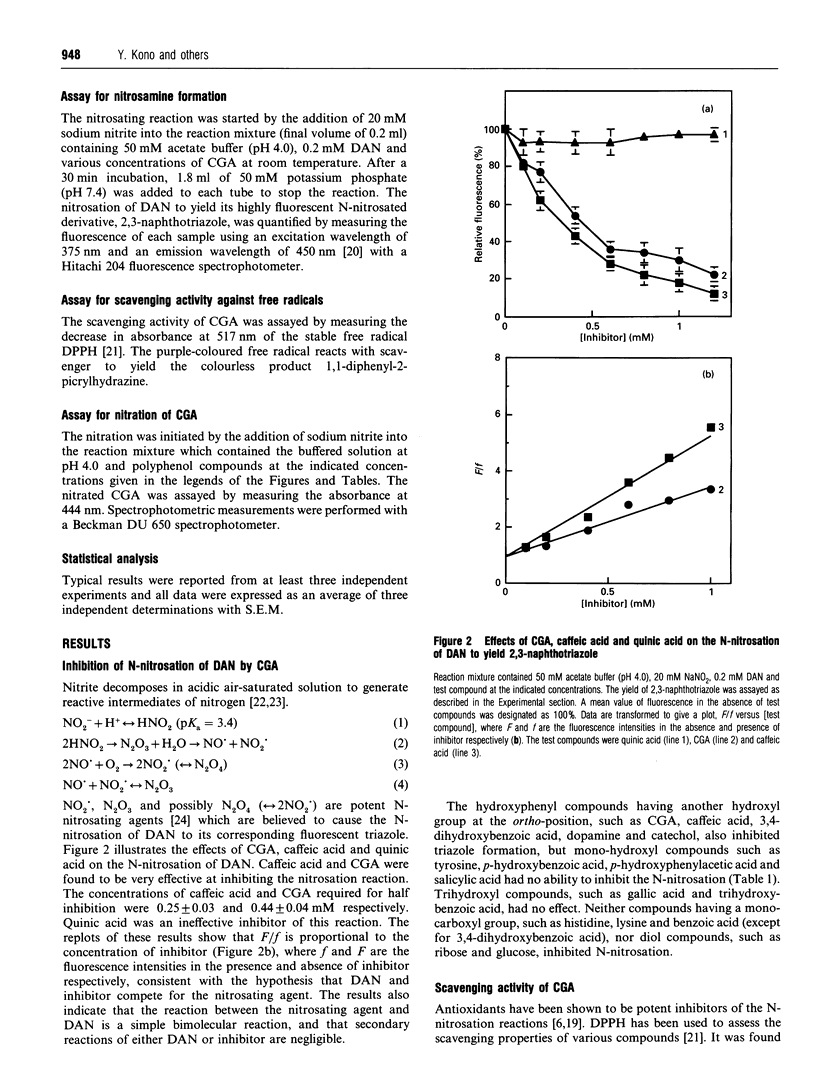
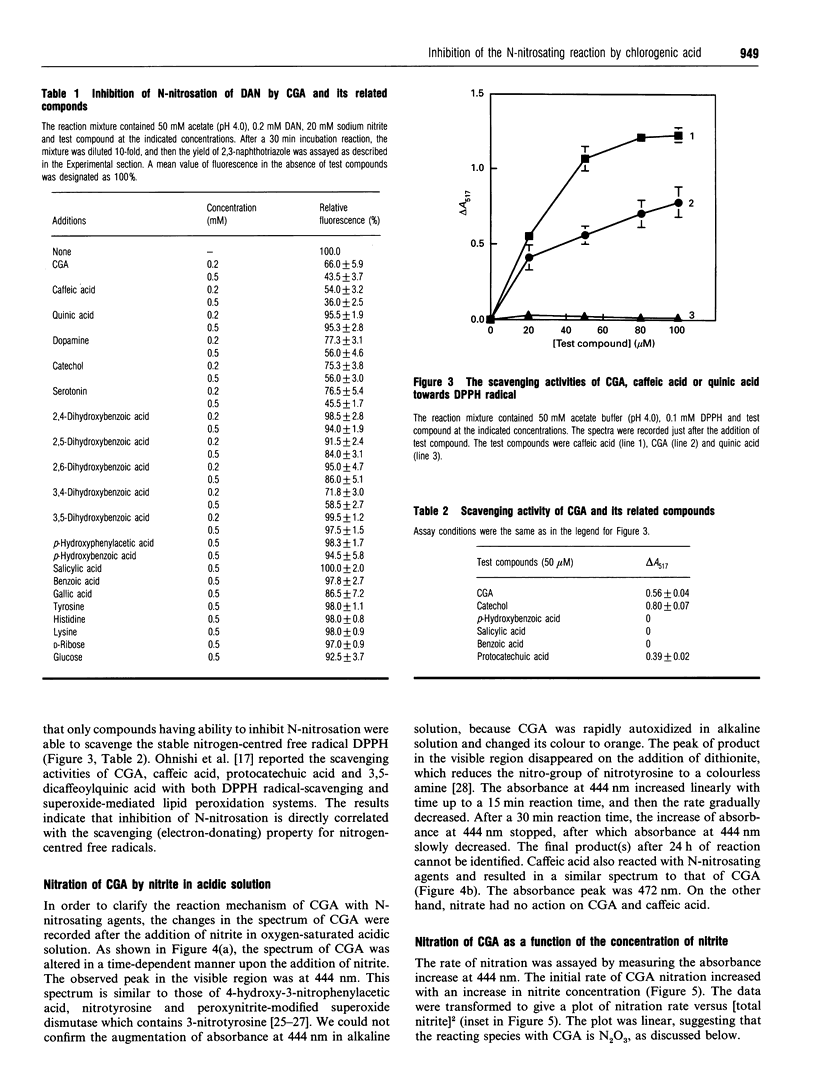
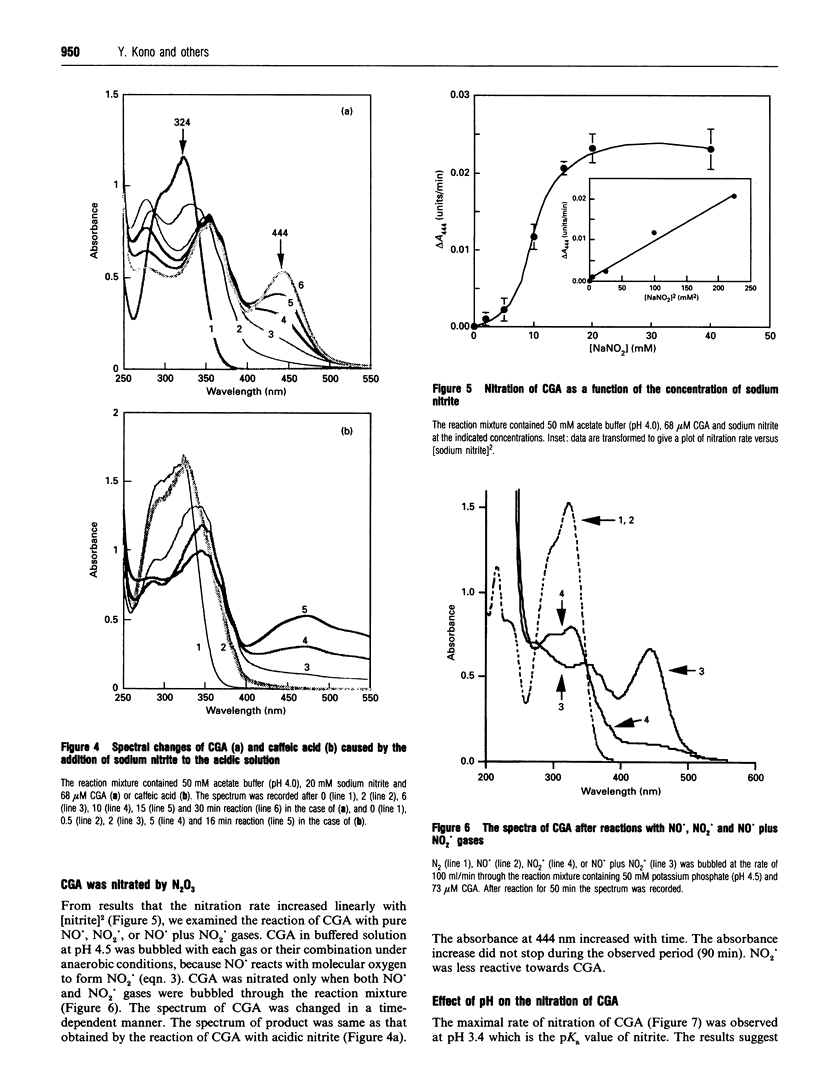
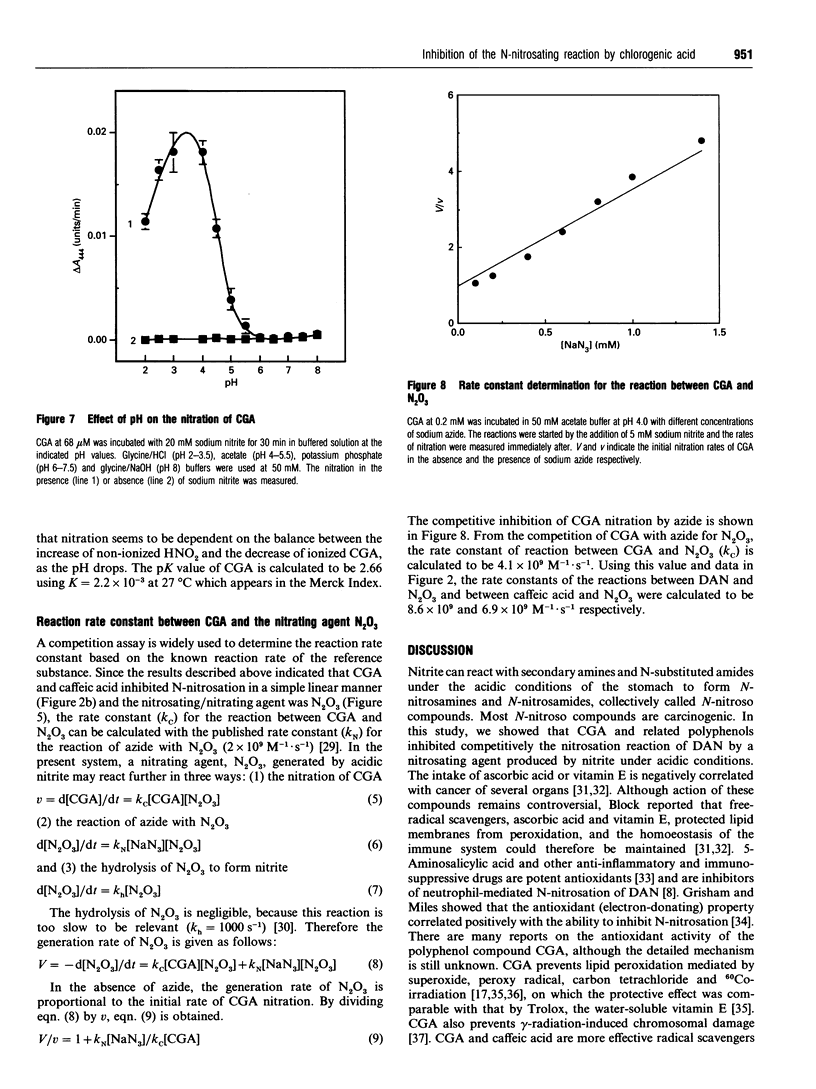
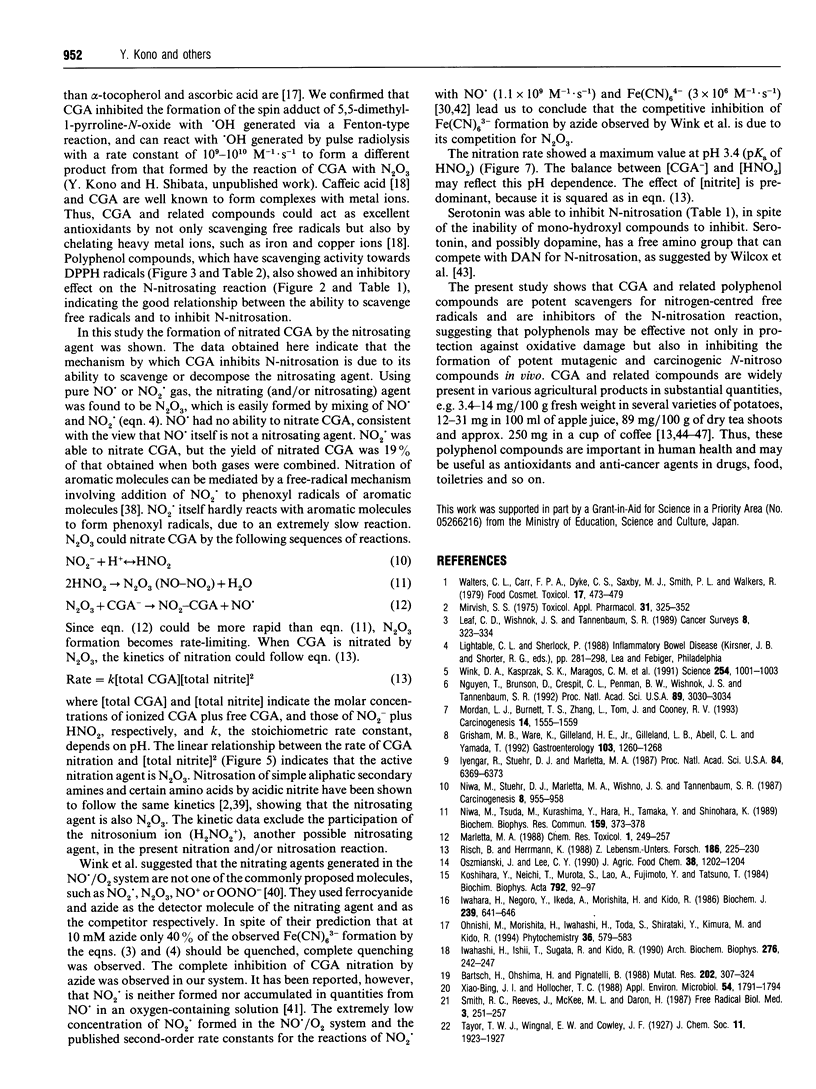
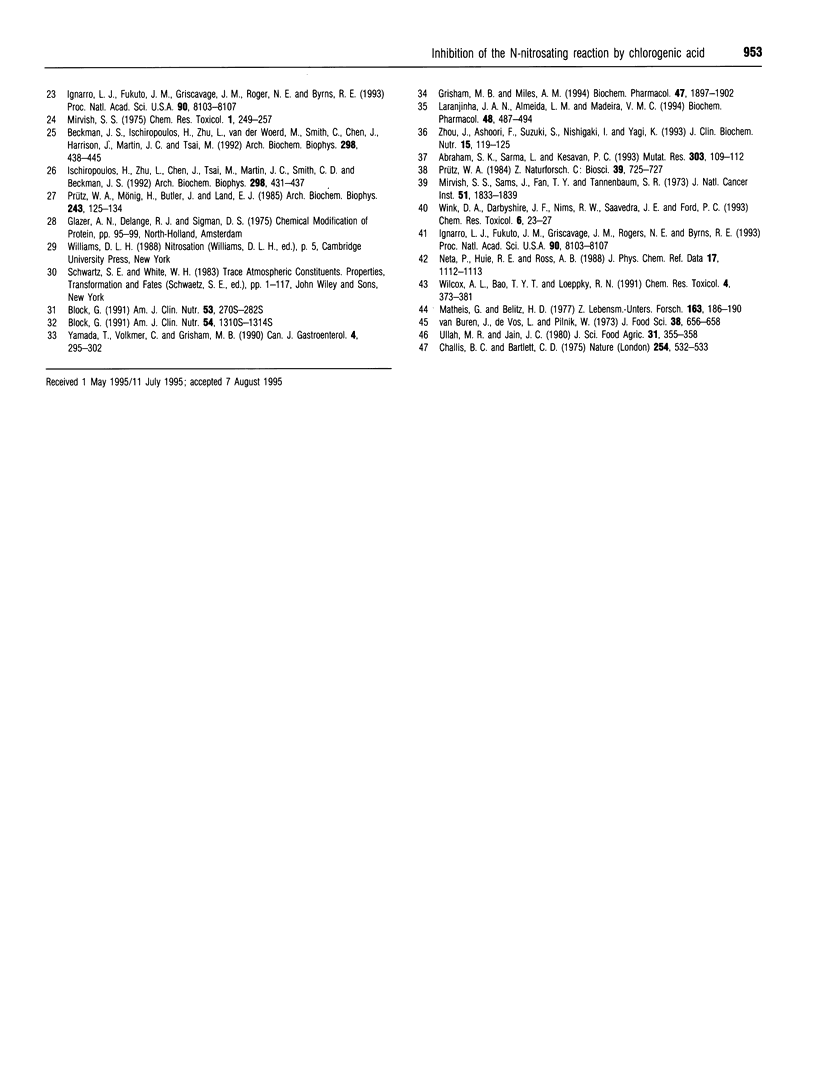
Selected References
These references are in PubMed. This may not be the complete list of references from this article.
- Abraham S. K., Sarma L., Kesavan P. C. Protective effects of chlorogenic acid, curcumin and beta-carotene against gamma-radiation-induced in vivo chromosomal damage. Mutat Res. 1993 Nov;303(3):109–112. doi: 10.1016/0165-7992(93)90022-n. [DOI] [PubMed] [Google Scholar]
- Bartsch H., Ohshima H., Pignatelli B. Inhibitors of endogenous nitrosation. Mechanisms and implications in human cancer prevention. Mutat Res. 1988 Dec;202(2):307–324. doi: 10.1016/0027-5107(88)90194-7. [DOI] [PubMed] [Google Scholar]
- Beckman J. S., Ischiropoulos H., Zhu L., van der Woerd M., Smith C., Chen J., Harrison J., Martin J. C., Tsai M. Kinetics of superoxide dismutase- and iron-catalyzed nitration of phenolics by peroxynitrite. Arch Biochem Biophys. 1992 Nov 1;298(2):438–445. doi: 10.1016/0003-9861(92)90432-v. [DOI] [PubMed] [Google Scholar]
- Block G. Epidemiologic evidence regarding vitamin C and cancer. Am J Clin Nutr. 1991 Dec;54(6 Suppl):1310S–1314S. doi: 10.1093/ajcn/54.6.1310s. [DOI] [PubMed] [Google Scholar]
- Block G. Vitamin C and cancer prevention: the epidemiologic evidence. Am J Clin Nutr. 1991 Jan;53(1 Suppl):270S–282S. doi: 10.1093/ajcn/53.1.270S. [DOI] [PubMed] [Google Scholar]
- Challis B. C., Bartlett C. D. Possible cocarcinogenic effects of coffee constituents. Nature. 1975 Apr 10;254(5500):532–533. doi: 10.1038/254532a0. [DOI] [PubMed] [Google Scholar]
- Grisham M. B., Miles A. M. Effects of aminosalicylates and immunosuppressive agents on nitric oxide-dependent N-nitrosation reactions. Biochem Pharmacol. 1994 May 18;47(10):1897–1902. doi: 10.1016/0006-2952(94)90320-4. [DOI] [PubMed] [Google Scholar]
- Grisham M. B., Ware K., Gilleland H. E., Jr, Gilleland L. B., Abell C. L., Yamada T. Neutrophil-mediated nitrosamine formation: role of nitric oxide in rats. Gastroenterology. 1992 Oct;103(4):1260–1266. doi: 10.1016/0016-5085(92)91513-4. [DOI] [PubMed] [Google Scholar]
- Ignarro L. J., Fukuto J. M., Griscavage J. M., Rogers N. E., Byrns R. E. Oxidation of nitric oxide in aqueous solution to nitrite but not nitrate: comparison with enzymatically formed nitric oxide from L-arginine. Proc Natl Acad Sci U S A. 1993 Sep 1;90(17):8103–8107. doi: 10.1073/pnas.90.17.8103. [DOI] [PMC free article] [PubMed] [Google Scholar]
- Ignarro L. J., Fukuto J. M., Griscavage J. M., Rogers N. E., Byrns R. E. Oxidation of nitric oxide in aqueous solution to nitrite but not nitrate: comparison with enzymatically formed nitric oxide from L-arginine. Proc Natl Acad Sci U S A. 1993 Sep 1;90(17):8103–8107. doi: 10.1073/pnas.90.17.8103. [DOI] [PMC free article] [PubMed] [Google Scholar]
- Ischiropoulos H., Zhu L., Chen J., Tsai M., Martin J. C., Smith C. D., Beckman J. S. Peroxynitrite-mediated tyrosine nitration catalyzed by superoxide dismutase. Arch Biochem Biophys. 1992 Nov 1;298(2):431–437. doi: 10.1016/0003-9861(92)90431-u. [DOI] [PubMed] [Google Scholar]
- Iwahashi H., Ishii T., Sugata R., Kido R. The effects of caffeic acid and its related catechols on hydroxyl radical formation by 3-hydroxyanthranilic acid, ferric chloride, and hydrogen peroxide. Arch Biochem Biophys. 1990 Jan;276(1):242–247. doi: 10.1016/0003-9861(90)90033-u. [DOI] [PubMed] [Google Scholar]
- Iwahashi H., Negoro Y., Ikeda A., Morishita H., Kido R. Inhibition by chlorogenic acid of haematin-catalysed retinoic acid 5,6-epoxidation. Biochem J. 1986 Nov 1;239(3):641–646. doi: 10.1042/bj2390641. [DOI] [PMC free article] [PubMed] [Google Scholar]
- Iyengar R., Stuehr D. J., Marletta M. A. Macrophage synthesis of nitrite, nitrate, and N-nitrosamines: precursors and role of the respiratory burst. Proc Natl Acad Sci U S A. 1987 Sep;84(18):6369–6373. doi: 10.1073/pnas.84.18.6369. [DOI] [PMC free article] [PubMed] [Google Scholar]
- Ji X. B., Hollocher T. C. Mechanism for nitrosation of 2,3-diaminonaphthalene by Escherichia coli: enzymatic production of NO followed by O2-dependent chemical nitrosation. Appl Environ Microbiol. 1988 Jul;54(7):1791–1794. doi: 10.1128/aem.54.7.1791-1794.1988. [DOI] [PMC free article] [PubMed] [Google Scholar]
- Koshihara Y., Neichi T., Murota S., Lao A., Fujimoto Y., Tatsuno T. Caffeic acid is a selective inhibitor for leukotriene biosynthesis. Biochim Biophys Acta. 1984 Jan 17;792(1):92–97. [PubMed] [Google Scholar]
- Laranjinha J. A., Almeida L. M., Madeira V. M. Reactivity of dietary phenolic acids with peroxyl radicals: antioxidant activity upon low density lipoprotein peroxidation. Biochem Pharmacol. 1994 Aug 3;48(3):487–494. doi: 10.1016/0006-2952(94)90278-x. [DOI] [PubMed] [Google Scholar]
- Leaf C. D., Wishnok J. S., Tannenbaum S. R. Mechanisms of endogenous nitrosation. Cancer Surv. 1989;8(2):323–334. [PubMed] [Google Scholar]
- Marletta M. A. Mammalian synthesis of nitrite, nitrate, nitric oxide, and N-nitrosating agents. Chem Res Toxicol. 1988 Sep-Oct;1(5):249–257. doi: 10.1021/tx00005a001. [DOI] [PubMed] [Google Scholar]
- Matheis G., Belitz H. D. Untersuchungen zur enzymatischen Bräunung bei Kartoffeln (Solanum tuberosum). II. Quantitative Beziehung zwischen Bräunung und Inhaltsstoffen. Z Lebensm Unters Forsch. 1977 Mar 21;163(3):186–190. doi: 10.1007/BF01459855. [DOI] [PubMed] [Google Scholar]
- Mirvish S. S. Formation of N-nitroso compounds: chemistry, kinetics, and in vivo occurrence. Toxicol Appl Pharmacol. 1975 Mar;31(3):325–351. doi: 10.1016/0041-008x(75)90255-0. [DOI] [PubMed] [Google Scholar]
- Mirvish S. S., Sams J., Fan T. Y., Tannenbaum S. R. Kinetics of nitrosation of the amino acids proline, hydroxyproline, and sarcosine. J Natl Cancer Inst. 1973 Dec;51(6):1833–1839. doi: 10.1093/jnci/51.6.1833. [DOI] [PubMed] [Google Scholar]
- Miwa M., Stuehr D. J., Marletta M. A., Wishnok J. S., Tannenbaum S. R. Nitrosation of amines by stimulated macrophages. Carcinogenesis. 1987 Jul;8(7):955–958. doi: 10.1093/carcin/8.7.955. [DOI] [PubMed] [Google Scholar]
- Miwa M., Tsuda M., Kurashima Y., Hara H., Tanaka Y., Shinohara K. Macrophage-mediated N-nitrosation of thioproline and proline. Biochem Biophys Res Commun. 1989 Mar 15;159(2):373–378. doi: 10.1016/0006-291x(89)90001-6. [DOI] [PubMed] [Google Scholar]
- Mordan L. J., Burnett T. S., Zhang L. X., Tom J., Cooney R. V. Inhibitors of endogenous nitrogen oxide formation block the promotion of neoplastic transformation in C3H 10T1/2 fibroblasts. Carcinogenesis. 1993 Aug;14(8):1555–1559. doi: 10.1093/carcin/14.8.1555. [DOI] [PubMed] [Google Scholar]
- Nguyen T., Brunson D., Crespi C. L., Penman B. W., Wishnok J. S., Tannenbaum S. R. DNA damage and mutation in human cells exposed to nitric oxide in vitro. Proc Natl Acad Sci U S A. 1992 Apr 1;89(7):3030–3034. doi: 10.1073/pnas.89.7.3030. [DOI] [PMC free article] [PubMed] [Google Scholar]
- Prütz W. A., Mönig H., Butler J., Land E. J. Reactions of nitrogen dioxide in aqueous model systems: oxidation of tyrosine units in peptides and proteins. Arch Biochem Biophys. 1985 Nov 15;243(1):125–134. doi: 10.1016/0003-9861(85)90780-5. [DOI] [PubMed] [Google Scholar]
- Smith R. C., Reeves J., McKee M. L., Daron H. Reaction of methylated urates with 1,1-diphenyl-2-picrylhydrazyl. Free Radic Biol Med. 1987;3(4):251–257. doi: 10.1016/s0891-5849(87)80032-1. [DOI] [PubMed] [Google Scholar]
- Walters C. L., Carr F. P., Dyke C. S., Saxby M. J., Smith P. L., Walker R. Nitrite sources and nitrosamine formation in vitro and in vivo. Food Cosmet Toxicol. 1979 Oct;17(5):473–479. doi: 10.1016/0015-6264(79)90006-3. [DOI] [PubMed] [Google Scholar]
- Wilcox A. L., Bao Y. T., Loeppky R. N. Pyrroles as effective agents for blocking amine nitrosation. Chem Res Toxicol. 1991 May-Jun;4(3):373–381. doi: 10.1021/tx00021a019. [DOI] [PubMed] [Google Scholar]
- Wink D. A., Darbyshire J. F., Nims R. W., Saavedra J. E., Ford P. C. Reactions of the bioregulatory agent nitric oxide in oxygenated aqueous media: determination of the kinetics for oxidation and nitrosation by intermediates generated in the NO/O2 reaction. Chem Res Toxicol. 1993 Jan-Feb;6(1):23–27. doi: 10.1021/tx00031a003. [DOI] [PubMed] [Google Scholar]
- Wink D. A., Kasprzak K. S., Maragos C. M., Elespuru R. K., Misra M., Dunams T. M., Cebula T. A., Koch W. H., Andrews A. W., Allen J. S. DNA deaminating ability and genotoxicity of nitric oxide and its progenitors. Science. 1991 Nov 15;254(5034):1001–1003. doi: 10.1126/science.1948068. [DOI] [PubMed] [Google Scholar]


